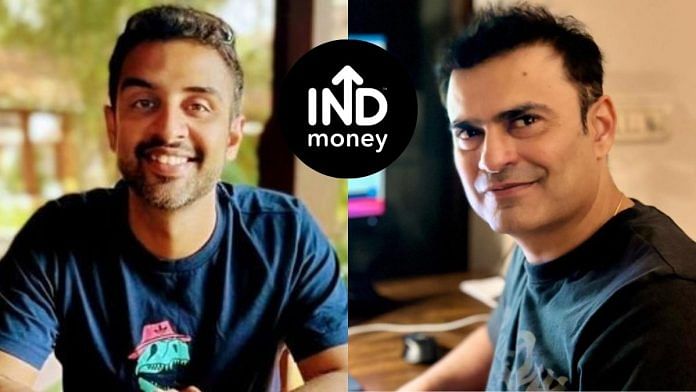However, a relatively newer player in the brokerage landscape has gained remarkable attention this month. Within two weeks of Trump’s tariff announcement on 2 April, INDmoney saw a 400 percent month-on-month spike in fresh investments by Indian investors in US stocks.
Ranked as the 11th largest brokerage firm in India and the fastest growing by National Stock Exchange, the Gurugram-based investech start-up was founded by Ashish Kashyap and Nikhil Behl in 2019. The super finance app allows users to invest in stocks, mutual funds, Initial Public Offers (IPOs) and fixed deposits, alongside US stocks. INDmoney has gained significant momentum over the last two years.
Reacting to the huge traffic on the platform in the first week of April, Behl, the company’s CEO (stocks), posted on X on 6 April: “Can y’all (sic) please chill on the US stocks investments this is insane our team needs sleep!”
Can yall please chill on the US stocks investments this is insane our team needs sleep! @INDmoneyApp
#USstocks pic.twitter.com/5jPiwkBJNz— Nikhil Behl (@Nikhilbehl_) April 6, 2025
“Following the recent tariff announcements, interest in US stocks on our platform has surged. Investor participation has already surpassed previous highs for the year, marking a record-breaking month on multiple fronts. Over 40 percent of these fresh inflows were directed toward the iconic MAANG stocks, underscoring how investors are viewing the correction as a strategic buying opportunity,” Behl told ThePrint. “The trend is clear: Indian investors are rapidly diversifying globally and tapping into international growth stories.”
MAANG stands for Meta, Amazon, Apple, Netflix and Google.
Currently, INDmoney boasts of a userbase of over 17 million people. One of the features that it uses to its benefit, and that users have appreciated, is the range of wealth management options that the platform provides. These include the Indian stock market, mutual funds, futures and options, National Pension System, IPOs, and US stocks.
One move that has worked well for the company, according to Behl, is fractional trading.
“Fractional trading has become mainstream on our platform. This innovation empowers users not just to start investing with smaller amounts—like buying as little as $1 worth of Tesla or Apple—but also provides better precision in asset allocation, allowing investors to deploy their exact intended amount into any stock without being constrained by the share price. This clearly indicates an increasingly informed and highly engaged retail investor base.”
Fractional trading is defined as investing a small amount of money in buying a certain portion of a high-priced stock/share, which may not be affordable for small investors.
Behl added that initially, the highest traffic on the app and website was from investors wanting to invest in the ‘Magnificient 7’ stocks (Apple, Alphabet or Google, Microsoft, Amazon, Meta, Tesla and Nvidia), but many customers are now leaning towards ETFs, enabling diversification across various sectors like AI and robotics, and global markets like China and Europe.
“On our platform, for US stocks, most people hold their investments for medium-to-long term, and investments in ETFs vs direct stocks has gone from 20-80 percent, to 40-60 percent in recent years,” he said.
At INDmoney, Behl has overseen the company’s foray into US equities, Indian stock trading and cross-border investing. Previously, Behl worked as a quant analyst and trader, and had co-founded FlameBack Capital, a SEBI-registered advisory firm, as well as a food tech start-up.
Kashyap, INDmoney’s other co-founder, has been a key figure in India’s tech and internet ecosystem. He previously founded the Ibibo Group—home to brands like Goibibo and redBus—which later merged with MakeMyTrip, in what was then the country’s largest tech M&A deal. He has also co-founded digital payments platform PayU India, and previously served as Google India’s country head.
Also Read: Not politicians, India’s wealthiest families underreporting incomes, finds study by DSE director
How INDmoney invests in US markets
A lot of Indians are turning to overseas markets, especially the US, to diversify their investment portfolios. The US market, with a large pool of companies listed on the exchange, provides investors the opportunity to buy shares of big heads, like Apple and Tesla. The US market is also known to give higher returns, compared to Indian stock exchanges, and currency appreciation can further enhance them.
INDmoney has structured its US stock investment offerings through a dual approach that leverages both the GIFT City framework and direct partnerships with US-registered brokers. It facilitates international investing via its group entity, INDmoney Global, which is registered as a broker-dealer with the International Financial Services Centres Authority (IFSCA) at GIFT City.
Users have the option to invest in US markets in two ways—directly trading in stocks listed on US exchanges, or gaining exposure to leading American companies via Unsponsored Depository Receipts (DRs) listed on the NSE IFSC exchange.
For those opting to invest directly in US equities, INDmoney holds partnership with SEC-registered brokerage firms in the US. Upon completing the Know Your Customer (KYC) process and onboarding, a US brokerage account is created in the investor’s name through one of these partner firms. The company claims to have streamlined the funding process, allowing users to load their US stock wallet effortlessly.
To enable quick cross-border transfers, INDmoney also has tie-ups with several leading private sector banks in India. These partnerships, the firm says, ensure that funds can be transferred to US brokerage accounts within a matter of hours, making the overall investing process smooth and user-friendly through the INDmoney app.
Funding, revenue & market valuation
Since its inception, INDmoney has raised $133 million—the last funding round being in January 2022, in which they secured $75 million, valuing the company at over $600 million. Prominent investors include Tiger Global, Steadview Capital and ABG Capital.
According to recent filings, INDmoney’s operating revenue rose to Rs 70 crore in FY24, up from Rs 40.6 crore in FY23. Total revenue, factoring in other income streams, reached Rs 128 crore—a substantial portion of which came from interest and gains on the company’s sizeable financial assets worth Rs 725 crore—in March 2024.
A closer look reveals that Rs 57.7 crore of this income was generated through returns on current investments, underscoring INDmoney’s strategy of leveraging capital reserves for financial cushioning.
Despite the revenue growth, the start-up’s losses widened 12 percent year-on-year, hitting Rs 82.55 crore in FY24, up from Rs 73.9 crore the previous year. This growing deficit highlights the cost-intensive nature of INDmoney’s expansion efforts as it seeks to entrench itself in India’s crowded fintech space, alongside heavyweights, like Zerodha, Groww and Upstox.
Distribution services were INDmoney’s main revenue driver, contributing 76 percent to the operating revenue and clocking Rs 53.6 crore in FY24—a 56 percent jump from the previous year. Meanwhile, revenue from broking activities exploded from just Rs 10 lakh in FY23 to Rs 10.7 crore in FY24.
The fintech firm’s total expenditure stood at Rs 233.6 crore in FY24, a 17 percent increase from the previous year. The lion’s share went towards employee benefits, which amounted to Rs 124.53 crore—an 11 percent year-on-year rise. Technology remained a key investment area, with IT expenses tallying Rs 57.18 crore, while marketing efforts consumed Rs 33.80 crore, signalling an aggressive push for customer acquisition.
(Edited by Mannat Chugh)
Also Read: V is not for victory, but volatility—what is VIX & why are Trump’s tariffs roiling the ‘fear gauge’
var ytflag = 0;
var myListener = function() {
document.removeEventListener(‘mousemove’, myListener, false);
lazyloadmyframes();
};
document.addEventListener(‘mousemove’, myListener, false);
window.addEventListener(‘scroll’, function() {
if (ytflag == 0) {
lazyloadmyframes();
ytflag = 1;
}
});
function lazyloadmyframes() {
var ytv = document.getElementsByClassName(“klazyiframe”);
for (var i = 0; i < ytv.length; i++) {
ytv[i].src = ytv[i].getAttribute('data-src');
}
}








